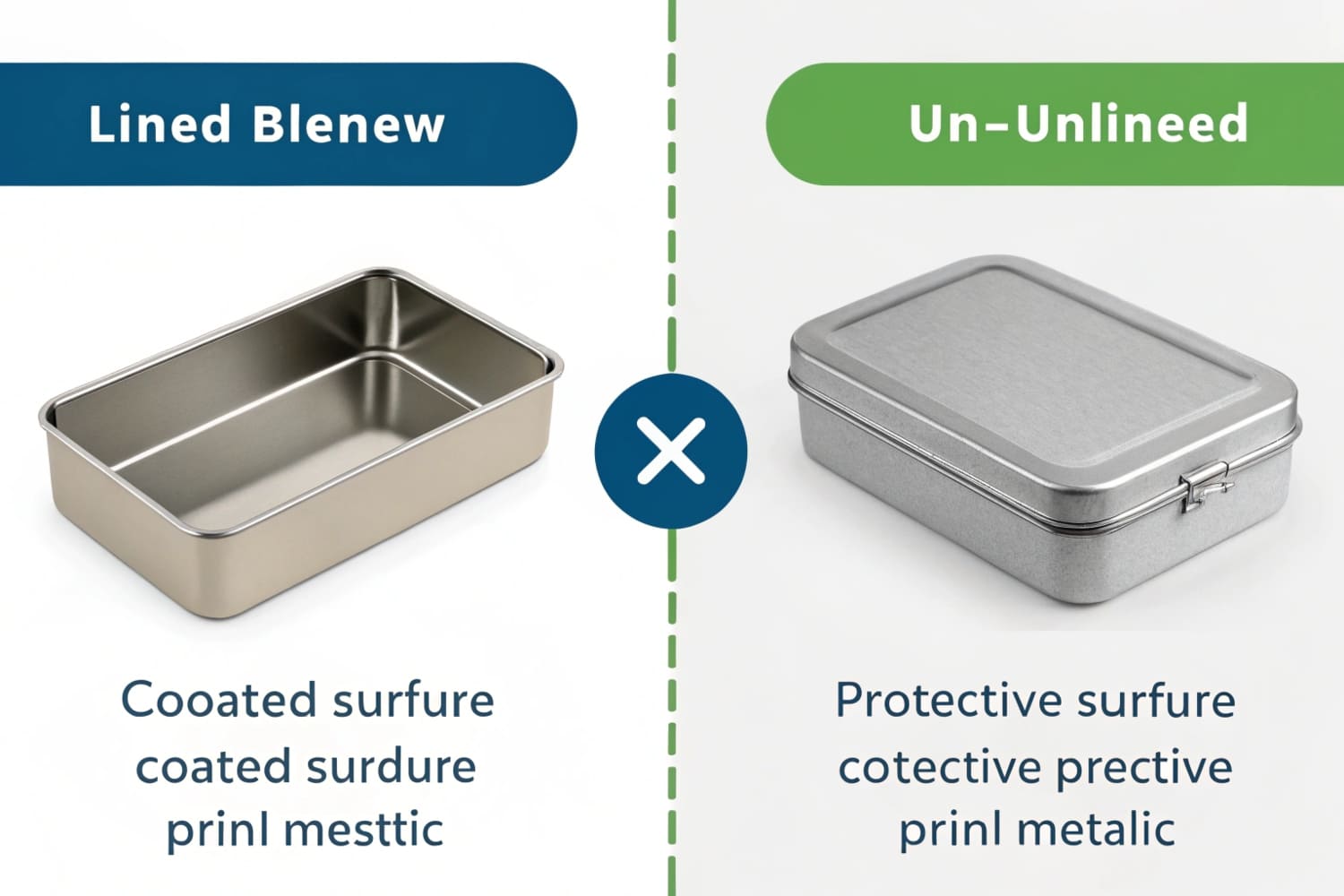I see confusion everywhere. People love the look of tin. People worry about safety. I run a cardboard display factory, yet I also guide clients on packaging choices. I want to give a clear answer.
Most modern “tin” boxes are steel with a tinplate or lacquer coating; they are food safe when they use a certified food-grade lacquer and proper seams, and they are unsafe if the coating is damaged or not rated for direct food contact.
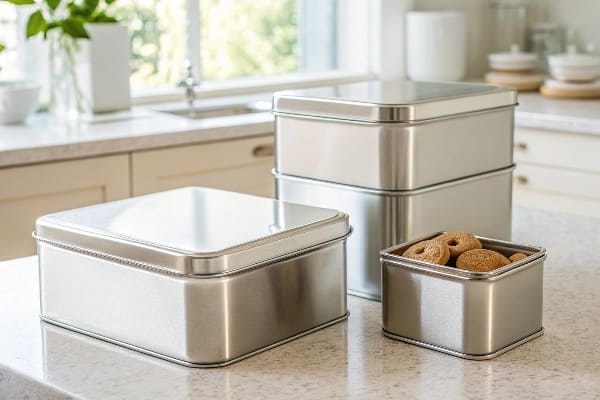
I will keep this simple. I will explain what “tin” means today. I will show when a tin box is safe. I will show when it is not. I will also compare metal boxes with other options I sell, like cardboard displays and display packaging. Then you can choose with confidence.
Are tin containers food safe?
Many buyers ask me this first. They see a shiny box on a shelf. They want the same box for cookies or tea. They also fear metal taste or rust. The fear is fair.
Tin containers are food safe if they use food-grade coatings and clean seams, pass migration tests, and stay undamaged; uncoated interiors, scratched lacquers, and rusty spots are not food safe.
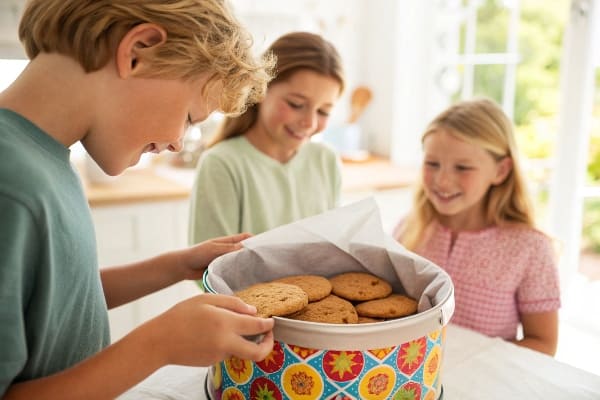
What “tin” means and how safety works
Most “tin” boxes are tinplate steel. The steel gives strength. A thin layer of tin helps resist rust. A clear or white lacquer often coats the inside. That lacquer does the heavy lifting for safety. When the lacquer is food-grade and applied well, the food does not touch bare metal. When the lacquer chips, the protection fails. I ask suppliers for documents: material datasheets, coating declarations, and migration test reports1. I also do a quick wipe test on new lots. If I smell strong solvent after a day, I reject that batch.
Key checks I use
| Checkpoint | What I look for | Why it matters |
|---|---|---|
| Interior coating | Food-grade epoxy, polyester, or polyolefin (PO) lacquer | Keeps food from touching metal |
| Seam design | Smooth, no sharp edges, no pinholes | Stops leaks and rust points |
| Print inks | Low-odor, compliant for packaging | Avoids taint and odor transfer |
| Certificates | FDA/EU food contact declarations, migration test | Confirms legal safety |
| Condition | No dents, scratches, or rust | Damage breaks the barrier |
Practical note from my projects
I supply cardboard displays, not cans. Yet many clients ask me to coordinate their metal gift tins for seasonal launches. I learned to ask for a coated interior even for dry cookies. I also ask for desiccant in humid lanes. This simple step keeps the tin fresh and safe during ocean transit.
Can I store food in tin containers?
Clients love to pack tea, candy, or cookies in a branded tin. The shelf look is strong. The lid feels premium. Storage sounds easy. But storage still needs rules.
You can store dry, low-moisture foods in coated tin containers short to medium term; avoid high-acid, high-salt, or wet foods unless the container has the right food-grade lining and verified barrier performance.
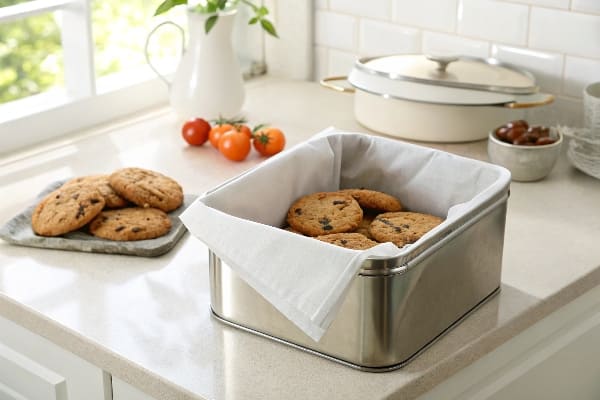
What to store and for how long
I store dry foods2 like cookies, crackers, candies, loose-leaf tea, or whole-bean coffee in lined tins. I avoid wet foods like sauces. I avoid cut fruit. I avoid pickles. These foods are acidic or salty. They need stronger linings or full cans with hermetic seams. For dry goods, a tight lid with a gasket is best. I also add an inner bag. A simple food-grade pouch reduces odor pickup and keeps crumbs from scratching the lacquer.
Storage guidance I share with buyers
| Food type | Tin storage advice | Extra tip |
|---|---|---|
| Cookies, crackers | Good in coated tins | Use inner bag for freshness |
| Candy, mints | Good in coated tins | Watch for sugar stickiness in heat |
| Tea, coffee | Good in coated tins | Add gasket; protect from light |
| Spices | Possible but check aroma transfer | Use inner glassine or PET bag |
| Wet/acid foods | Not recommended without special lining | Choose glass or true canning |
Small habits that make tins work
I wipe the inside with a dry lint-free cloth before filling. I never wash the tin with harsh soap. I avoid dishwashers. If I must clean, I use mild soap, rinse fast, and dry fully. I do not stack heavy tins that might dent lids. A dent can break the seal and invite moisture. Simple habits keep the lining intact and safe.
Are metal containers safe for food?
Many teams compare metal with paper or plastic. They ask me which is safer. I say that safety depends on the barrier, not the mystique of the material. Paper can be safe. Metal can be safe. Plastic can be safe. Each has rules.
Metal containers are safe for food when coatings, inks, and seams meet food-contact standards and remain undamaged; safety comes from the barrier system and quality control, not from metal alone.
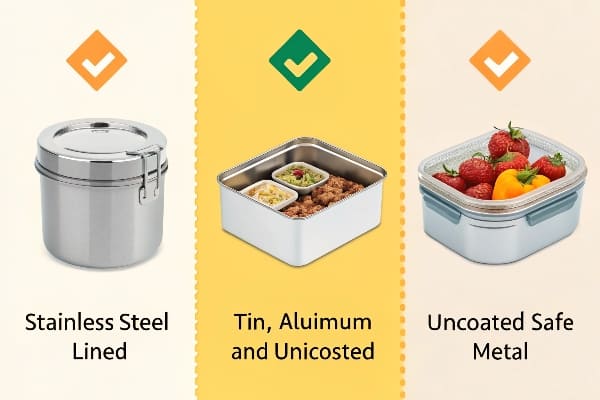
Metal vs paper vs plastic in real launches
I run B2B projects for displays and launch kits. We combine a cardboard display with a metal gift tin or a paper canister. For safety, I check contact layers first. Metal uses lacquer. Paper uses food-safe liners3 or films. Plastic uses approved resins. I review migration test data4 and odor tests. I place a sample in a closed box with a neutral cookie overnight. If the cookie smells like ink in the morning, I flag the lot. This simple test saves a season.
Side-by-side view
| Aspect | Metal (tinplate) | Paper/Paperboard | Plastic (PET/PP) |
|---|---|---|---|
| Barrier | Excellent with lacquer | Needs liner or film | Varies by resin and wall |
| Strength | High | Medium | Medium |
| Odor risk | Low with good coating | Medium if ink not isolated | Low to medium |
| Recyclability | Widely recyclable | Widely recyclable | Varies by locale |
| Cost | Medium to high | Low to medium | Medium |
| Best use | Premium dry foods | Gift packs, dry foods | Pouches, jars |
My quality routine for mixed materials
I ask suppliers for lot numbers and coating types. I keep retain samples for each batch. I test a small pilot before a big run. I simulate transport. I use a shaker and a heat box to mimic a week in a container. I want to see if the lid rubs the lacquer. If I see scratches, I add an inner tray or a soft insert. This is simple risk control. It keeps food safe and keeps launches on time.
What are the disadvantages of tin food packaging?
Teams love the premium look. Still, they should see the trade-offs. A tin is not perfect. It can fail if the coating chips. It can dent. It can cost more.
Tin food packaging can dent, scratch, and rust if coatings fail; it usually costs more, needs strict coating control, and may require inner bags to protect food and keep freshness.
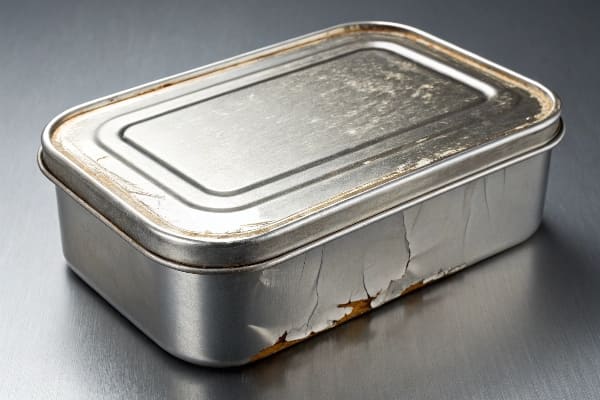
Where tins struggle and how I fix it
Tins dent under point loads. A corner hit can bend a lid and break the seal. I use foam corners or stronger outer cartons. Coatings can scratch during packing. I ask for slip sheets between stacked tins. Humidity can drive rust on raw edges. I add VCI paper or desiccant in ocean loads. Cost is higher than paper tubes or folding cartons. I reserve tins for premium lines5, seasonal gifts, or collector editions where the brand gets value from reuse.
Disadvantage map
| Disadvantage | Cause | Mitigation |
|---|---|---|
| Dents and lid gaps | Drop or point load | Better outer pack, foam corners |
| Coating scratches | Abrasion in transit | Slip sheets, inner bags |
| Rust on edges | Moisture exposure | Desiccant, VCI, dry warehouse |
| Higher unit cost | Material + printing + tooling | Use for premium SKUs only |
| Odor taint risk | Poor inks or coatings | Specify low-odor systems, test |
| Compliance risk | Missing documents | Require declarations and tests |
When I advise cardboard instead
I run a factory for cardboard displays6. For many launches, a custom paper canister with a foil liner plus a strong display hits the sweet spot. It costs less, prints fast, and ships flat. It also avoids dent risk. I often pair a small metal badge or lid to keep a premium feel. This mix gives brand impact and keeps food safe with a known liner. It also moves faster when deadlines are tight in the U.S. and Canada retail cycles.
Conclusion
Tin boxes are safe when coatings and seams are right; use lined tins for dry foods, avoid wet foods, and protect coatings with inner bags and smart packing.
These reports are essential for verifying the safety of food contact materials, ensuring consumer protection. ↩
Explore this link to learn effective methods for storing dry foods to maintain their freshness and quality. ↩
Exploring food-safe liners will help you grasp their role in maintaining food quality and safety. ↩
Understanding migration test data is crucial for ensuring food safety and compliance in packaging materials. ↩
Exploring this resource will reveal how premium lines enhance brand value and customer perception. ↩
This link will provide insights into the advantages of cardboard displays for effective marketing and cost efficiency. ↩

